What Animal Poops In Same Place On Top Of Old Poop
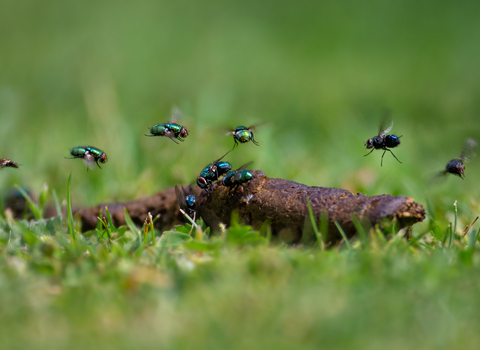
©Jon Hawkins - Surrey Hills Photography
What animal poo is this?
What poo is this?
Have you found some animal poo? Sometimes wildlife is difficult to spot, peculiarly if it'south nocturnal, and so debris are a peachy way of finding out who is visiting your neighbourhood or garden at dark. Hither are some common British mammal debris yous might come up beyond, every bit well as some tips on what to look - or smell - for!
Hedgehog debris ©Darren Tansley
Hedgehogs
Hedgehog droppings are about v cm long, cylindrical and generally quite dark. They might be filled with bits of insects and worms.
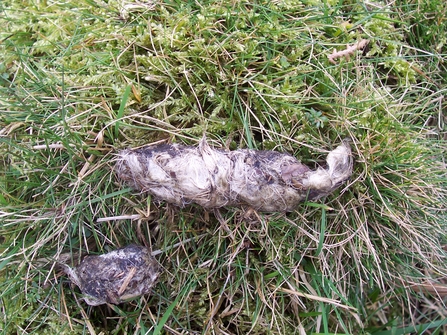
Flim-flam scat ©Sue Crookes
Foxes
Foxes produce domestic dog-like droppings that are usually pointy at i terminate and full of fur, feathers, tiny bones, seeds and berries. In rural areas, fox poo is quite dark, simply in urban areas, where foxes eat human food waste matter, it can be lighter. Fresh droppings have a distinctively musky or 'foxy' smell.
Rabbit and hare debris ©Darren Tansley
Rabbits and hares
Droppings are left in clusters of little, circular, difficult assurance. They are ordinarily yellowy-brown or green in colour, and full of grass. Hare droppings (on the right) tend to exist slightly bigger and flatter than rabbit droppings (left hand side).
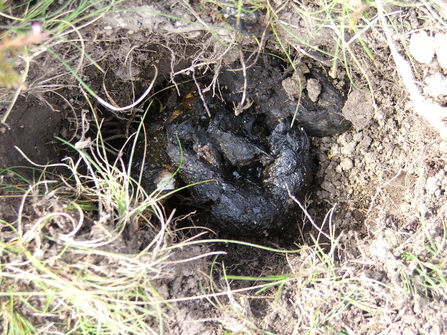
Badger droppings in latrine ©Montgomeryshire Wildlife Trust
Badgers
Badgers poo in shallow pits chosen 'latrines'. Their droppings vary from house and sausage-shaped, to softer, slimier and darker if they've been eating lots of worms! Badger droppings take a sugariness, musky smell.
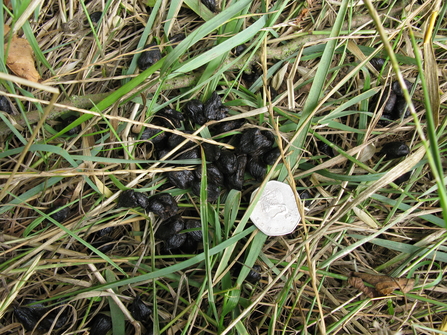
Deer droppings ©Darren Tansley
Deer
Considering deer ruminate (regurgitate and chew their nutrient twice before digesting it), at that place are no obvious contents in their droppings. They produce smoothen, shiny, dark pellets that are pointy at i end and often stuck together in clusters. Deer that live in the UK include Chinese water deer, dormant deer, muntjac, red deer, roe deer and sika.
Otter spraint ©Darren Tansley
Otters and American mink
Both these mammals are constitute in similar wetland habitats. Otters produce droppings known as 'spraints', which are left in prominent places along riverbanks, on rocks or under bridges to mark out their territories. Otter spraints are unremarkably dark green, slimy and full of fish bones, scales and crayfish parts. The 'scats' of American mink are smaller, black and contain fur, feathers and bones. Fresh otter poo smells similar jasmine tea, while mink poo has a much less pleasant scent. This image is of an otter spraint!
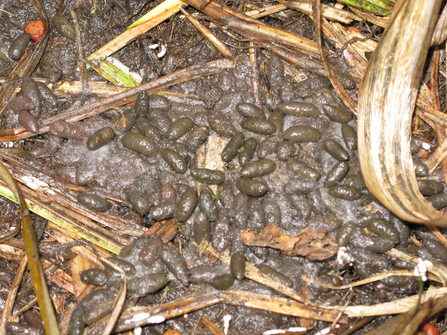
Water vole droppings © Darren Tansley
H2o voles, rats and mice
Though they inhabit like wetland habitats, the debris of water voles and rats have several key differences. Water voles leave their debris in large 'latrines' (piles), close to the water, whereas rats leave theirs in smaller numbers forth paths. Water vole debris are smaller than rat debris and are rounded at both ends; rat droppings are flattened at 1 cease and pointy at the other. Water vole droppings are green, chocolate-brown or purple, have a putty-like texture and no stiff aroma. Rat droppings are light dark-brown to black, slimy and soft, and smell unpleasantly like wee. Mice produce very similar debris to rats, merely they are much smaller.
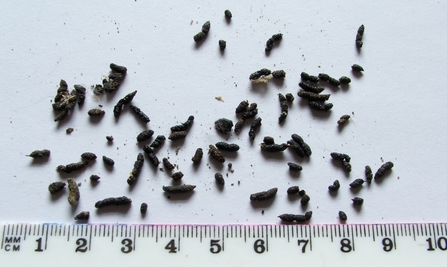
Bat debris ©Montgomeryshire Wild animals Trust
What do I do if I come up across animal poo?
You might encounter animal poo when yous are at dwelling house, either in your garden or your outhouses, or when you lot're out in the countryside. To identify it, take a notation of the size, shape and colour, and pause information technology apart with a stick to run across what's inside. But never touch it – it can contain harmful bacteria!
It looks like poo, but could it be something else?
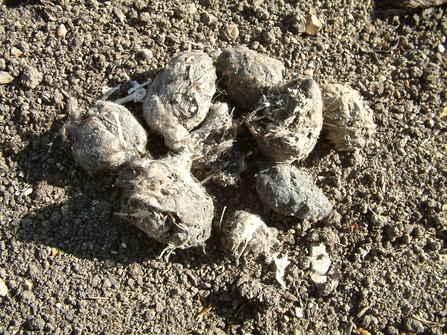
Owl pellets ©Martha Cowell
Owl pellets
Owls regurgitate parts of their food that they cannot digest, such every bit the fur and basic of small mammals and birds. These 'pellets' can look like animal droppings, only exercise not smell and gradually turn grey as they dry out.
Learn how to identify owls
How you can help
Equally a charity we rely on memberships. They help us look after over 2,300 nature reserves and protect the animals that call them home.
Join for as little equally £iii a month
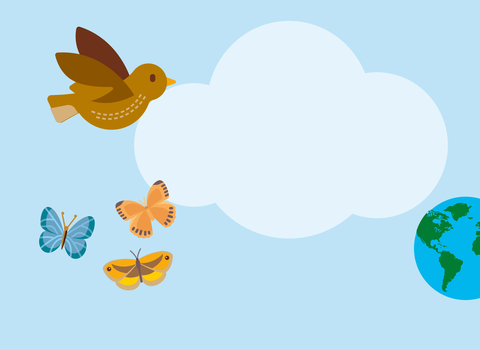
Source: https://www.wildlifetrusts.org/wildlife/how-identify/identify-poo
Posted by: frostdescear.blogspot.com

0 Response to "What Animal Poops In Same Place On Top Of Old Poop"
Post a Comment